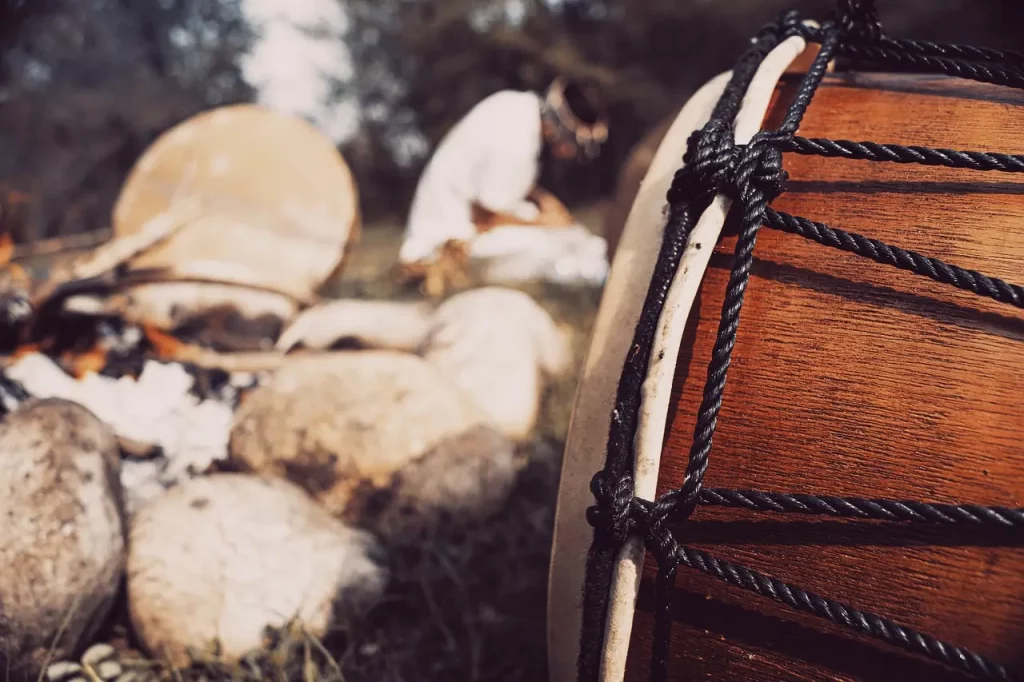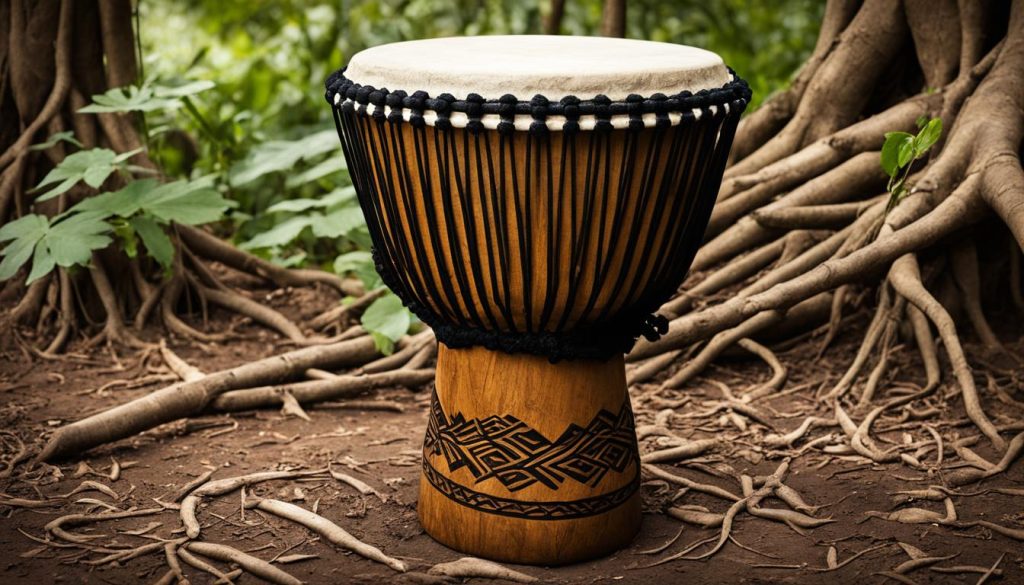When you hear the word “djembe,” what comes to mind? Is it the rich sound of an African drum, or perhaps the vibrant cultural heritage of West Africa?
The djembe holds a special place in the hearts of many, and its significance goes far beyond just a musical instrument. But, what does djembe mean?
The name “djembe” is derived from the Bamana people of Mali, who used the phrase “Anke dje, anke be” to call their people together, meaning “everyone gathers together.”

Content
The Meaning of Djembe Drums
The djembe is a goblet-shaped drum that originated in West Africa.
Carved from a single piece of African hardwood and topped with an animal skin drumhead, it is not only visually captivating but also carries deep cultural symbolism.
This reflects the drum’s role as a unifying force, bringing communities together through its powerful rhythms.
But what does the djembe symbolize? Its significance goes beyond just its name.
The drum represents unity, communication, and the spirit of the ancestors. It is said to contain the spirits of the tree from which it was made, the animal whose skin is played, and the instrument maker.
When played, the djembe comes alive, filling the air with a powerful energy that resonates with both the players and the listeners.
The djembe drum has a rich history dating back 400-800 years to the time of the Malian Empire.
It was created by the Mandé people, who belonged to the Numu caste of blacksmiths. Initially played during smelting rituals, the djembe gradually gained popularity among different castes and became an instrument played by djembefola, or those skilled in playing the djembe.
Today, the djembe drum is not only cherished in its place of origin but has also gained global recognition. Its captivating sound has inspired musicians and enthusiasts worldwide to embrace its rhythms and incorporate them into various genres of music.
So, the next time you hear the word “djembe,” remember its rich heritage, its symbolic significance, and the power it holds to bring people together.
Whether you play the drum or simply appreciate its sound, the djembe is more than just an instrument—it is a cultural treasure that bridges continents and echoes the heartbeat of West Africa.
Origins and History of the Djembe Drum
The origins of the djembe drum can be traced back to the Mandé people of West Africa, who are believed to have invented it around 1300 AD.
The drum is closely associated with the Malian Empire, which encompassed modern-day Mali, Senegal, Guinea, and Ivory Coast.
The Mandé society was structured into different castes, with the blacksmith caste, known as the Numu, being the first to be linked with the djembe.
The Numu blacksmiths played the djembe during the smelting of iron ore, using it as a means of communication and expression.
As the drum grew in popularity, it became recognized as an instrument played by the djembefola – the skilled musicians who mastered the art of the djembe.
Over time, the djembe and its culture spread across the regions of West Africa as blacksmiths migrated to different areas.
Throughout its history, the djembe has been more than just a musical instrument. It has served as a symbol of cultural identity, heritage, and community cohesion for the Mandé people and other West African societies.
The craftsmanship of the djembe is a testament to the skill and artistry of the blacksmiths, who meticulously carve the drum from a single piece of African hardwood, and the drumheads are traditionally made from animal skins.
The Mandé people have passed down their knowledge of djembe making through generations, ensuring that this ancient craft continues to thrive.
The djembe’s significance extends beyond its musical capabilities, as it is a powerful cultural artifact that embodies the spirit and history of West Africa.
Variations of the Djembe Drum
| Region | Description |
|---|---|
| Mali | The traditional djembe drum is characterized by its hourglass shape and intricate carving designs. |
| Guinea | The Guinean djembe is known for its larger size and deeper bass tones, often used in performance ensembles. |
| Senegal | The Senegalese djembe features a smaller size and lighter construction, allowing for faster and more intricate playing techniques. |
| Ivory Coast | The Ivorian djembe is recognized for its unique carving patterns and distinctive sound. |
Legends and Symbolism Surrounding the Djembe Drum
The origin of the djembe drum is shrouded in various legends and myths, each adding to its mystical appeal and cultural significance.
These legends often intertwine with the rich oral traditions of West African societies. One popular legend proposes that the basic shell of the djembe evolved from a large mortar used for grinding grain or millet.
The transformation from a utilitarian tool to a musical instrument highlights the ingenuity and adaptability of African craftsmanship.
Another enchanting tale tells the story of a trapper who captured a chimpanzee drummer in the depths of the forest. Over time, the trapper claimed the drum for human use, introducing it as a new element in the realm of music.
This legend emphasizes the connection between nature and human expression, as well as the transformative power of art.

The symbolism surrounding the djembe drum is deeply ingrained in African culture and spirituality. The drum is believed to house three spiritual essences.
The first is the spirit of the tree from which it was carved, representing the vitality and life force of nature. The second is the spirit of the animal whose skin is stretched and played, signifying the primal instincts and wild energy that the drum evokes.
Lastly, the spirit of the instrument maker imbues the djembe with their skill, dedication, and ancestral knowledge.
Combining these spirits, the djembe drum becomes a vessel through which the spirit of the djembe itself comes alive and communicates.
When the drum is played, it is not merely producing sound; it is believed to arouse and connect with the spirits, bridging the gap between the physical and spiritual realms.
The rhythmic beats and vibrations echo the heartbeats of the community, encouraging unity, harmony, and a sense of collective identity.
Cultural Significance of the Djembe Drum
The djembe drum holds great cultural significance in West African societies. It is not just a musical instrument; it is a symbol of unity, celebration, and the rich traditions of African music and dance.
From ceremonies to everyday gatherings, the djembe drum plays a vital role in various cultural events and rituals.
Uses of the Djembe Drum
The djembe drum is commonly used in a wide range of ceremonies and events in West Africa.
Whether it’s a marriage, baptism, funeral, or harvest celebration, the djembe sets the rhythm and creates an energetic atmosphere for participants to come together and celebrate. The powerful beats of the drum serve as a symbol of joy, celebration, and connection.
Additionally, the djembe drum accompanies songs and dances that tell stories of great leaders and honor specific professions.
Through the rhythmic beats of the drum, performers express their creativity, emotions, and cultural heritage.
Traditional Rhythms and Djembe Ensemble
The djembe drum is known for its versatility and ability to produce a wide range of traditional rhythms.
Each rhythm has its unique history, meaning, and cultural significance. These rhythms serve as a form of communication, storytelling, and a means to connect with the spiritual world.
In traditional African music, the djembe is often played in ensembles. The ensemble can consist of one soloist, accompanying djembe players, and bass drum players.
This collaborative approach creates a captivating and layered sound that brings the music to life, creating a mesmerizing experience for both the performers and the listeners.
African Music and Dance
The djembe drum is an integral part of African music and dance. It plays a crucial role in setting the rhythm and providing the foundation for dancers to express themselves.
The combination of the djembe’s vibrant sound and the energetic movements of the dancers creates a captivating performance that encapsulates the spirit and essence of African culture.
Through African music and dance, individuals can experience a deep connection with their cultural roots, celebrate their heritage, and promote unity among communities.
The djembe drum serves as a powerful tool in preserving and sharing the rich musical traditions of Africa.
Conclusion
The djembe drum holds a significant place in the cultural heritage of West Africa, particularly in Mali and Guinea. Its origins can be traced back to the Mandé people who created it around 1300 AD during the Malian Empire.
The drum symbolizes unity, communication, and the spirit of the ancestors, embodying the rich traditions and values of West African societies.
Over time, the djembe drum has gained global recognition and popularity. Musicians and enthusiasts from around the world have embraced its unique sound and rhythm, incorporating it into various music genres and performances.
The djembe has become an iconic instrument that transcends cultural boundaries, connecting people through the universal language of music.
Embracing the djembe drum not only allows you to explore the rich cultural heritage of West Africa but also provides a platform for cultural exchange and appreciation.
By learning to play this powerful instrument, you can participate in the preservation and celebration of African music and dance traditions, contributing to the global tapestry of artistic expression.
Experience the significance of the djembe drum for yourself and embark on a journey that connects you to the past, present, and future.
Join the global community of djembe enthusiasts and embrace the cultural heritage that this remarkable instrument represents. Let the rhythm of the djembe resonate within you and create harmony across borders.
